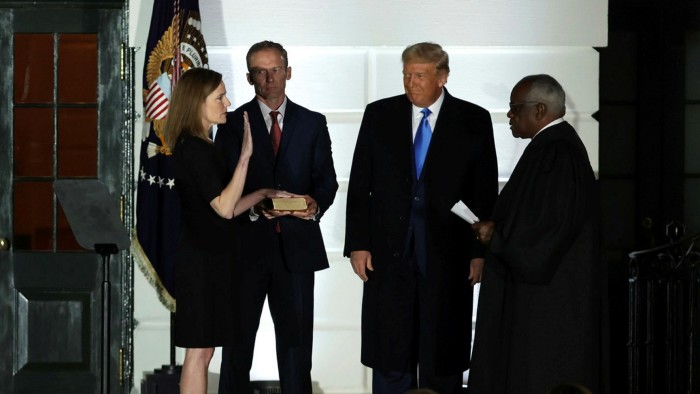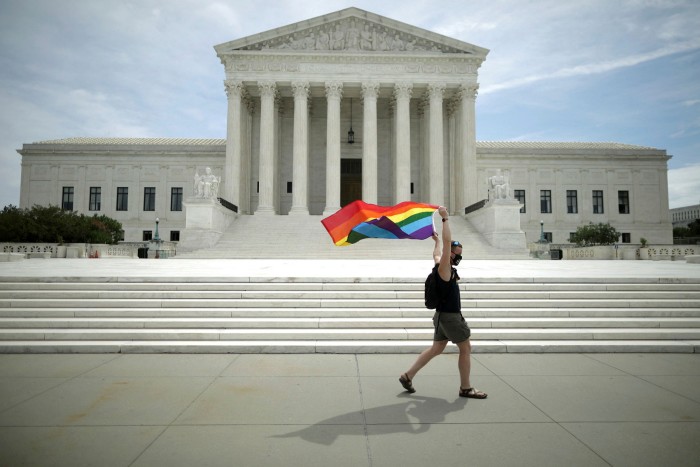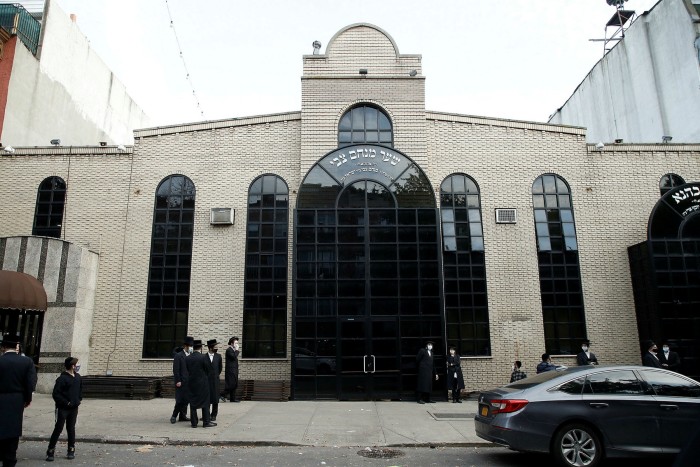US Supreme Court adjusts to new tilt to the right


Roula Khalaf, Editor of the FT, selects her favourite stories in this weekly newsletter.
The US Supreme Court is having adjustment problems. The addition of three conservative appointees by President Donald Trump in four years has disturbed the balance and possibly destroyed the comity of America’s highest court. The arrival of Amy Coney Barrett in October, replacing the late Ruth Bader Ginsburg, gives the court a 6-3 conservative majority after decades of a 5-4 split or control by a moderate block.
A court that has been reliably pro-business for years will stay that way at a time when incoming president Joe Biden is expected to favour stricter regulation and labour rights. The court also appears poised to invalidate or sharply narrow social reforms and government programmes that are popular with the majority of Americans, including abortion rights, gay marriage and Obamacare.
Some of the justices cannot wait. Samuel Alito, long one of the most conservative, recently complained in a speech that the court’s landmark 2015 gay rights decision in Obergefell vs Hodges had made traditional views unacceptable. “You can’t say marriage is a union between one man and one woman,” he said. “Until very recently, that’s what the vast majority of Americans thought. Now it’s considered bigotry.”

The significance of Ms Barrett’s arrival was underscored last month when the court blocked New York’s Covid-19 related restrictions on public religious services, saying they violated the freedom to worship. Before Ginsburg’s death, the court had upheld similar rules in California and Nevada, holding that they were necessary to control the pandemic and did not treat religious gatherings differently from secular ones.
The New York ruling was also notable for its many sharply worded opinions. Trump appointee Neil Gorsuch declared bitterly it was “past time” to strike down such restrictions, writing: “Even if the constitution has taken a holiday during this pandemic, it cannot become a sabbatical.”
The question now is not whether the court will move to the right, but how far. History shows that even though the justices are required to base their decisions on the constitution and legal precedent, popular opinion plays a role. After all, the court has no enforcement mechanism — it depends on the rest of government and the respect accorded to its rulings.
In the past, when Supreme Court rulings departed too far from public consensus, it has ended up adjusting. The best known instance is often described as the “switch in time that saved nine”.
In the 1935-36 terms, the justices capped a 40-year period of conservative rulings by striking down several New Deal statutes by 5-4 votes, drawing public opprobrium and a threat from then president Franklin Roosevelt to pack the court with additional liberals. While the bill was still pending, Owen Roberts changed sides — “switched” — and voted to uphold a Washington state minimum wage bill and continued to support regulation of business.
But liberals have seen the court shy away from confrontation as well. In 1954, in Brown vs Board of Education, the court invalidated segregated schools but put off immediate implementation, saying in Brown II a year later that states and school boards merely needed to act with “all deliberate speed”.

Chief Justice John Roberts has already shown he is deeply concerned with maintaining the Supreme Court’s institutional strength. For years, he has sometimes provided the liberals with a fifth vote on questions where he felt the court’s credibility could be at stake, including a 2012 ruling that turned back the first major challenge to the Affordable Care Act (ACA) that established Obamacare, and on cases regarding abortion rights and young immigrants last spring.
Early signs suggest he is still playing a similar role, even though Ginsburg’s death has shifted the balance on the court. At a time when the ACA is more popular than ever, he was openly sceptical in oral arguments of a new claim that Congress wanted the entire act to fail when it voted to change one part of it. In the New York Covid-19 religious services case, he defended his liberal colleagues from Justice Gorsuch’s criticism, saying “they simply view the matter differently after careful study”.
But Ms Barrett’s arrival means the chief justice can no longer make the difference on his own: he must bring along at least one conservative colleague to make a majority. In a landmark LGBT+ case last year, that extra conservative was Mr Gorsuch, and at the ACA hearing Brett Kavanaugh sounded sympathetic to Mr Roberts’ efforts to limit the reach of the case. But on the New York Covid-19 restrictions, the conservative bloc held.

After the ACA, the biggest early tests are likely to be in social policy cases involving gun rights and abortion. There already were five votes for pro-business decisions, so Ms Barrett’s arrival is unlikely to change the outcome of financial and regulatory cases.
On guns, the court has not taken up a recent case, but four justices previously supported an expansive approach to the second amendment right to bear arms. Ms Barrett expressed similar views as an appeals court judge. On abortion rights, the conservative bloc has criticised Roe vs Wade, the 1973 decision that proclaimed a constitutional right to have an abortion. Ms Barrett has signed public letters opposing abortion, and on the appeals court she dissented when other judges declined to rehear an Indiana case where tough abortion restrictions had been blocked.
Still, Supreme Court watchers know the institution’s history can place a powerful weight on its members. With the balance tilted to the political right, and an incoming administration committed to changes on climate and labour, the left will hope one or more of the justices will surprise.
The question remains: which could it be?
Comments